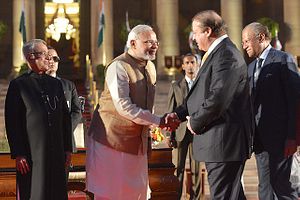In recent weeks, border tensions between India and Pakistan have risen to a new high. While border incursions and the exchange of fire between Indian and Pakistani troops along the Line of Control (LoC) have been a somewhat constant feature characterizing bilateral relations as of late, over the past week actions by both sides have resulted in civilian casualties. So far, at least five Indian civilians and four Pakistani civilians have been killed in the Kashmir region, mostly by overnight mortar fire. At least two dozen more have been injured on both sides. The fighting represents the worst escalation between the two nuclear-armed neighbors since they fought a limited war in the late 1990s.
Both sides have exchanged threats and warnings recently. Arun Jaitley, the Indian defense minister, warned Pakistan against engaging in “adventurism” on the border, noting that India wil do whatever it takes to defend its territory and citizens. Jaitley suggested that India would make the price of attacking Indian territory “unaffordable” for Pakistan. Meanwhile, Pakistan issued a nuclear warning. Pakistan’s Federal Minister for States and Frontier Regions Lt. Gen. Abdul Qadir Baloch reportedly said that “India should realize the fact that Pakistan is a nuclear power.”
Ties between India and Pakistan appeared to be off to a good start when India elected Narendra Modi, a right-wing Hindu nationalist, prime minister earlier this year. Modi invited Pakistani Prime Minister Nawaz Sharif to his inauguration in May and the rapport between the two leaders seemed to signal an impending period of rapprochement in bilateral ties. More recently, however, the Indian side spurned Pakistani diplomatic overtures when Pakistan’s high commissioner in India met with Kashmiri separatists ahead of a scheduled high-level bilateral meeting. The recent spate of cross-border fire came after that incident.
For the moment, neither side seems to be intent on backing down. Following a month of protests in Islamabad, Nawaz Sharif’s government is relatively impotent in the face of the Pakistani army. Pakistan’s Chief of Army Staff Raheel Sharif, the top general in the country, has “reiterated that any provocation along the Line of Control will be responded [to] effectively,” according to a statement. Meanwhile, Narendra Modi has his hands tied — given his strong nationalist base and tough image, he is reluctant to be seen as an appeaser. Modi’s party, the Bharatiya Janata Party, additionally has high stakes riding on the outcome of the upcoming assembly elections in India-administered Kashmir. The BJP hopes to win a majority in the Muslim-majority region.
It remains to be seen if this level of violence will become a new normal for India and Pakistan in the coming year. 2013 represented a particularly bad year in terms of incidents at the LoC in Kashmir. While that trend continued in 2014, it was punctuated with brief periods of bilateral rapprochement. The key difference now is that India has a government with a considerably less restrained disposition. New Delhi’s willingness to escalate tit-for-tat on the border could lead to a new era of instability in Kashmir.

































